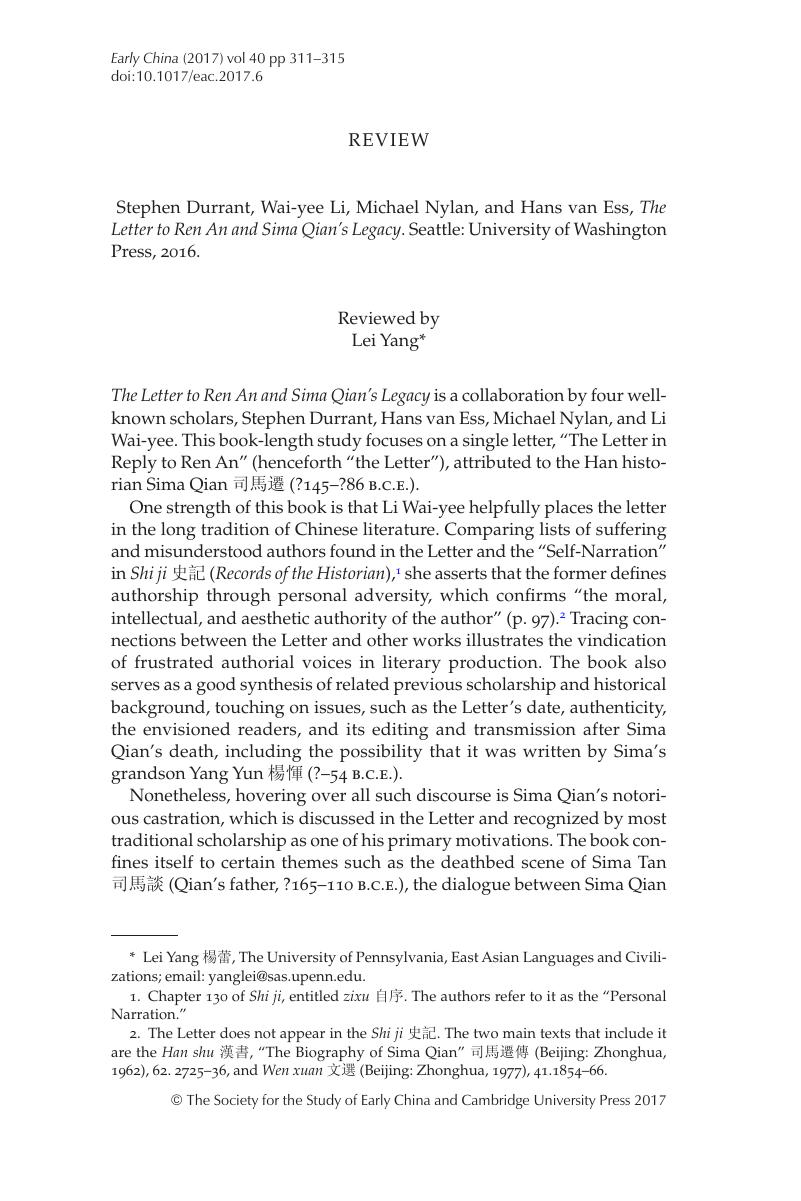Article contents
Stephen Durrant , Wai-yee Li , Michael Nylan , and Hans van Ess , The Letter to Ren An and Sima Qian's Legacy. Seattle: University of Washington Press, 2016.
Published online by Cambridge University Press: 12 October 2017
Abstract

- Type
- Reviews
- Information
- Copyright
- Copyright © The Society for the Study of Early China and Cambridge University Press 2017
References
1. Chapter 130 of Shi ji, entitled zixu 自序. The authors refer to it as the “Personal Narration.”
2. The Letter does not appear in the Shi ji 史記. The two main texts that include it are the Han shu 漢書, “The Biography of Sima Qian” 司馬遷傳 (Beijing: Zhonghua, 1962), 62. 2725–36, and Wen xuan 文選 (Beijing: Zhonghua, 1977), 41.1854–66.
3. I have discussed the problem of the intentional fallacy in Shi ji studies and proposed to read Shi ji from a narratological perspective in my dissertation, “Building Blocks of Chinese Historiography: A Narratological Analysis of Shi ji” (Ph.D. diss. University of Pennsylvania, 2016).
4. Wimsatt, W. K. Jr. and Beardsley, Monroe C., The Verbal Icon: Studies in the Meaning of Poetry (Lexington: University of Kentucky Press, 1954).Google Scholar
5. Gadamer discusses how readers interpret texts in Truth and Method, trans. Weinsheimer, Joel and Marshall, Donald G., 2nd ed. (New York: Continuum, 1989)Google Scholar. The quotation is from David Weberman’s article “Gadamer’s Hermeneutics and the Question of Authorial Intention,” in The Death and Resurrection of the Author, ed. Irwin, William (Westport: Greenwood Press, 2002), 45–46 Google Scholar.
6. For example, Shaoyong, Li 李少雍, Sima Qian zhuanji wenxue lungao 司馬遷傳記文學論稿 (Chongqing: Xinhua, 1987), 21 Google Scholar, claims that Sima, like Confucius, intended to stimulate and satirize (ciji 刺譏). Likewise, Hardy, Grant, Worlds of Bronze and Bamboo (New York: Columbia University Press, 1999)Google Scholar, further claims that Sima was using Emperor Wu to criticize the past, particularly the First Emperor. Changzhi, Li 李長之, Sima Qian zhi renge yu fengge 司馬遷之人格與風格 (Taibei: Kaiming, 1949), 369–77Google Scholar, contends that Sima actually used satires to embody his piercing insights into the Han society, especially towards Emperor Wu (157–87 b.c.e.). Durrant, , The Cloudy Mirror: Tension and Conflict in the Writings of Sima Qian, SUNY Series in Chinese Philosophy and Culture (Albany: State University of New York Press, 1995), 62–65 Google Scholar, argues that Sima Qian was and intended to be a second Confucius. Burton Watson’s position stands somewhere between Li Shaoyong and Durrant. He believes that Sima Qian intended to show that his work is similar to and different from Confucius’ work at the same time. See his Ssu-ma Ch’ien: Grand Historian of China (New York: Columbia University Press, 1958), 90 Google Scholar.
7. Guowei, Wang 王國維, “Taishigong xingnian kao” 太史公行年考, Guantang jilin 觀堂集林 (Taibei: Yiwen yinshu guan, 1956)Google Scholar; Ding, Shi 施丁, Sima Qian xingnian xinkao 司馬遷行年新考 (Xi’an: Shaanxi renmin, 1995)Google Scholar.
8. My translation. Nylan’s is “sought, like a seductive woman,” (75).
9. My translation.
10. The two poems are “Yuan You” 遠遊 (Far-off Journey) and “Qi Jian” 七諫 (Seven Remonstrances). The former is attributed to Qu Yuan, the latter to Dongfang Shuo 東方朔. But all these examples show that this phrase is commonly used when discussing ruler–minister relationships in Han texts.
11. See Shi ji 史記 (Beijing: Zhonghua, 1959)Google Scholar, 84. 2494. Han shu, 48. 2224.
12. Shi ji 86. 2519.
A correction has been issued for this article:
- 2
- Cited by
Linked content
Please note a has been issued for this article.


